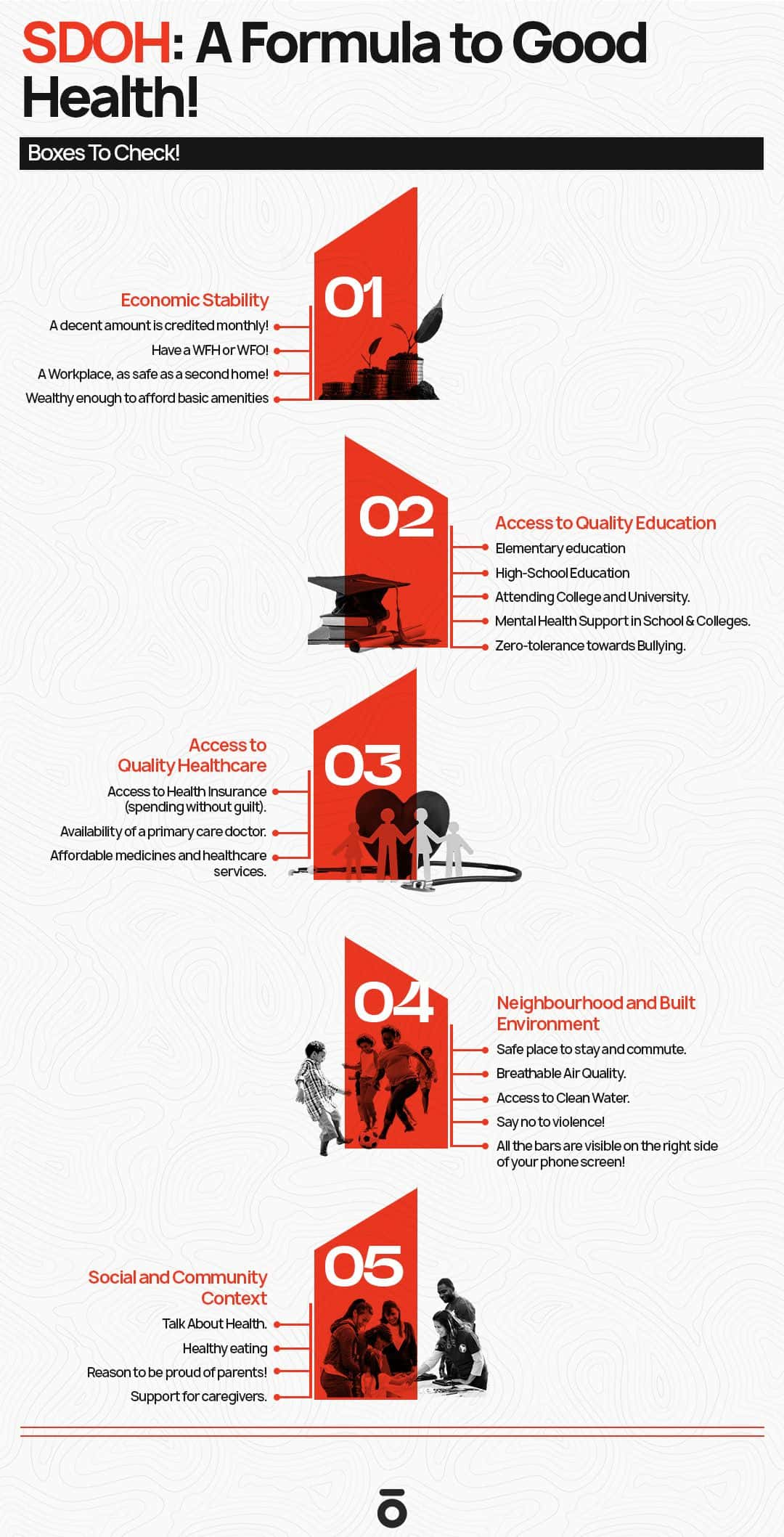What Is SDOH? Understanding Health Inequalities

Introduction
No, it is not sodium hydroxide. It is a concoction of different non-medical elements in our lives that control our health and happiness. India, a highly populated country where every little thing makes or breaks everything for someone, is highly dependent on SDOH. Your family, your friends and your job can influence more things than you can imagine. It is a veritable chain reaction that is your life.
This chain reaction is called SDOH and today we are going to talk about it. Let’s take a deep dive to understand how your surroundings actually matter.

The Key SDOH Determinants
Your Income
Income. It makes a huge difference to the quality of life that you will lead. With time, healthcare has improved manifolds. We have medicines for all of the possible diseases, barring a few. That should be great news, right? Well, yes, for some. For those who can afford it.
According to research, the average cost of medicine for patients in India is upwards of rs 4400/- per day. That’s more than what most people earn. Well, you could say, “But Rayomand, I am not sick, and I live a very healthy lifestyle.” My question to you would be, do you have family members to take care of? Do you have elderly parents?
The thing is, in India, 60% of families depend on a single earner. The median income of Indians is under four lakhs per annum, and there are 149 million Indians who are above 60. We are being conservative with the numbers here by not counting those who are above 50 and have co-morbidities.
We have also left out a lot of other things. Just to put how under-prepared we are on this conversation, I’d list a few things down here and you can judge if you think you can cover it with your income.
Cost of health insurance for a family of four (10 lakh coverage per annum): 30,000+
Cost of therapy: 1000 to 4000 per session
Cost of gym membership: 1000+
Cost of living for a single person: 25000+
Cost of rent: priceless.
Jokes apart, my point is the money issue is getting so out of hand that no amount of income is safe (if you are not A****i). So, to conclude that income is the biggest determinant of your health is an understatement of the size of a blue whale.
Your Education Level
Education - the ticket to a good life, and everything else, doesn’t come cheap. In India, education is a status symbol, the college that you have passed out of a calling card, to be used like a Shopper’s Stop discount coupon in every conversation that you have.
In any case, a postgraduate degree is required to live comfortably here, at the least! Ask any college graduate working in a BPO - how many times do you wish you could do your Master’s? But the problem is education is also not very easy to attain. If you google, you’d see that there are more than 1.5 million schools in India, but that does not paint the full picture.
Overall, 17% of students drop out of school after secondary education. In some states, the number is as high as 30%. In a country where the basic requirement for a job is graduation, it is fair to say that not enough people are getting that.
Advanced education is important as it opens the door for a better life. Graduation, post-graduation and higher education set you above the rest of the competition and can change your life.
Your Job and its Benefits
Your job. The reason you get up in the morning and well, exists. Your job dictates how happy or sad you are. Ask any sanitation worker about what they do and whether it makes them happy. You are bound to get some unique answers.
Today, it’s not only your job that matters. What benefits you get while you are working matters. Stuff like PF. Gratuity. How much free coffee you’re allowed at the office. Ask your newspaper delivery guy what benefits he gets at work. Chances are, there are none.
Your job will dictate your life. How much you can spend, how much you can save, when you can retire, which school your kids can go to… and every other thing that requires money. So make sure you are serious when you start your career.
The Availability of Resources in Your Neighbourhood
Resources matter. If they’re scarce in your neighbourhood, that matters too. Walk out of your house and look around. How many amenities can you see? Can you see a chemist? Well, that’s good for you. If you can spot a playground, or a park, good for you as well.
The average neighbourhood in India has a chemist and a school. Playgrounds might be a luxury for some, however. Not every neighbourhood has them. The resources that you have in the neighbourhood majorly impact health. Imagine if you had a park close by. Wouldn’t you go and exercise there? Exercise keeps you happy and healthy.
The Availability of Medical Care
The availability of medical care makes a huge difference to your health, mental or physical. Do you have a hospital in your neighbourhood? That might make things easier if a medical emergency arose.
Residential areas that have hospitals in them have happier residents because healthcare is just a stone’s throw away. But then again, hospitals aren’t cheap. When was the last time you checked into the Emergency ward because you had a common cold? Or you had a baby delivered?
Just for context, the cost of a baby delivery in India can range from Rs 33,095 to Rs 80,000 on average, with a maximum cost of Rs 80,000. The cost of a C-section delivery in India can range from Rs 50,000 to Rs 150,000, with an average cost of Rs 100,000.
The Quality of The Air You Breathe and Water you Drink
The kind of air you breathe and the water that goes into your stomach make a huge difference to your health. More than 163 million people in India do not have access to clean water, the highest in the world. For such people, daily life is a struggle.
In India, the entire population is exposed to unhealthy levels of air pollution. This is due to the high levels of particulate matter (PM2.5), which is the most harmful pollutant. People who breathe polluted air and drink contaminated water - their lives aren’t as rosy as ours.
Your Relationships and Social Connections
Do you live with your family? Life’s much better when you live with family. There are people you can talk to about anything that you want. Trouble at work? There’s a cousin who will listen to you - for free.
In 2021, the average household size in India was 4.44 people. This was a 0.9% decline from the previous year. This shows that people are moving more towards a nuclear family kind of setting.
There are also an alarming number of people living alone. According to a 2021 report, 5.7% of India's senior citizens (60 and older) live alone. This is a stark reminder that whenever you do meet anyone new, don’t forget to be nice. Some people go home to nothing.

Conclusion
In conclusion, if you have clean drinking water, breathe clean air, have a steady income, hold a good job, have medical care, resources in your neighbourhood, are educated and earn well, then your health would naturally be good. SDOH has a huge impact on people’s health and the way they live.
FAQs
What is SDOH?
Social Determinants of Health are factors like income, job, clean drinking water, relationships and social connections and more.
Does employment matter to health?
Whether you have a good job or not, makes a massive impact on your health. A good job ensures that you are healthier and happier.
I don’t have clean drinking water. Will I remain healthy?
If you do not drink clean drinking water, you will not really be healthy, or you might run into health problems.
I am a loner - will that impact my health?
Humans are social animals. If you do not maintain relationships in your life, you will not be as healthy as someone who does.
There’s a lot of pollution where I live. Will I be happy?
Clean air has a lot to do with good health. If you breathe clean air, then you stand to be healthier and happier than someone who lives in a polluted area.


Healthy Family Nutrition Tips for Strength and Togetherness

A Guide for First-Time Parents in 2025 – Best Advice

Work-Life Balance: Tips for a Happier, Healthier Lifestyle


